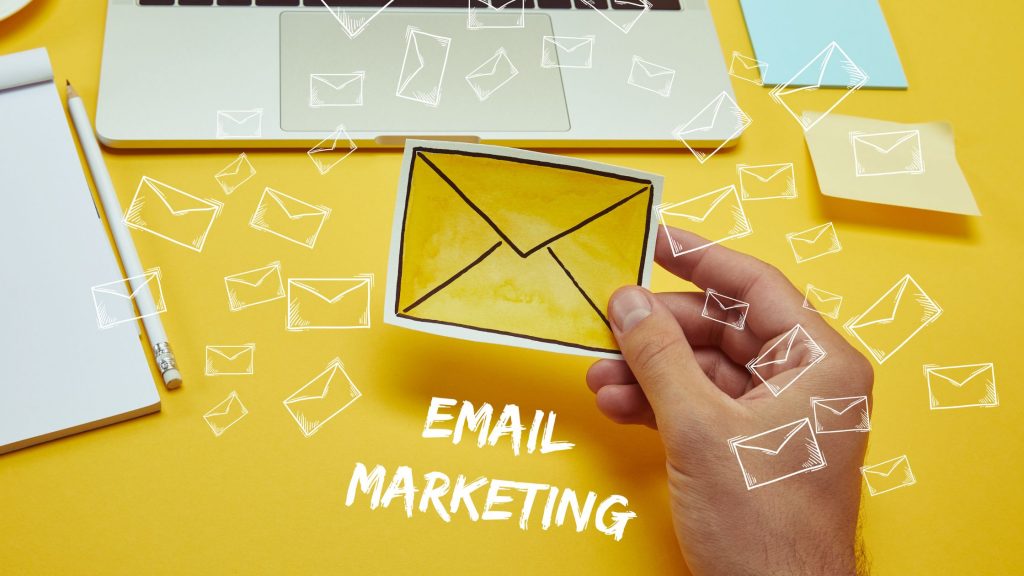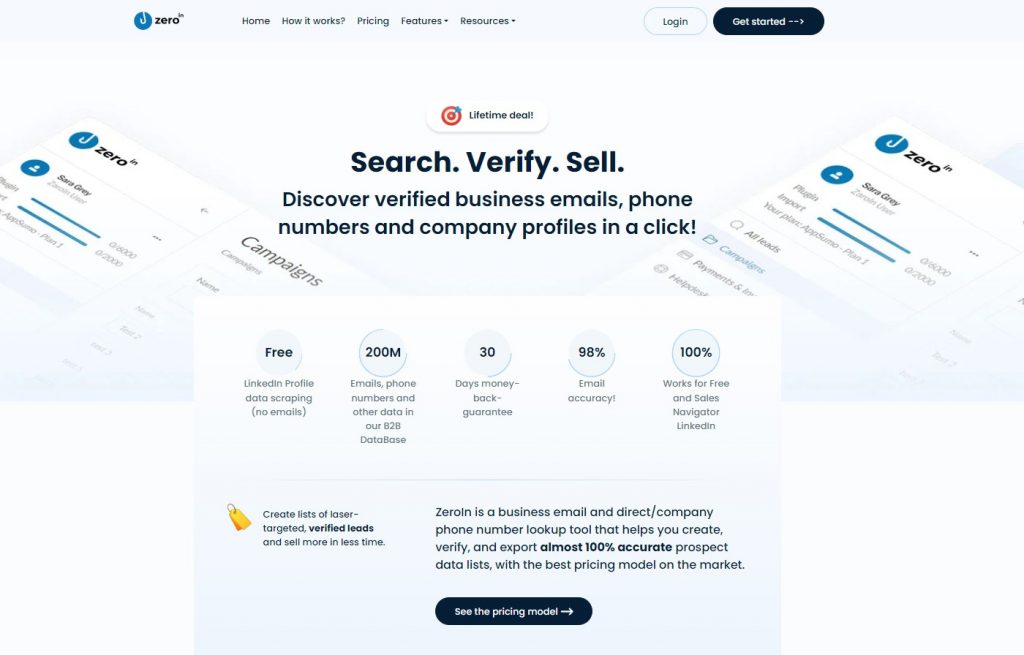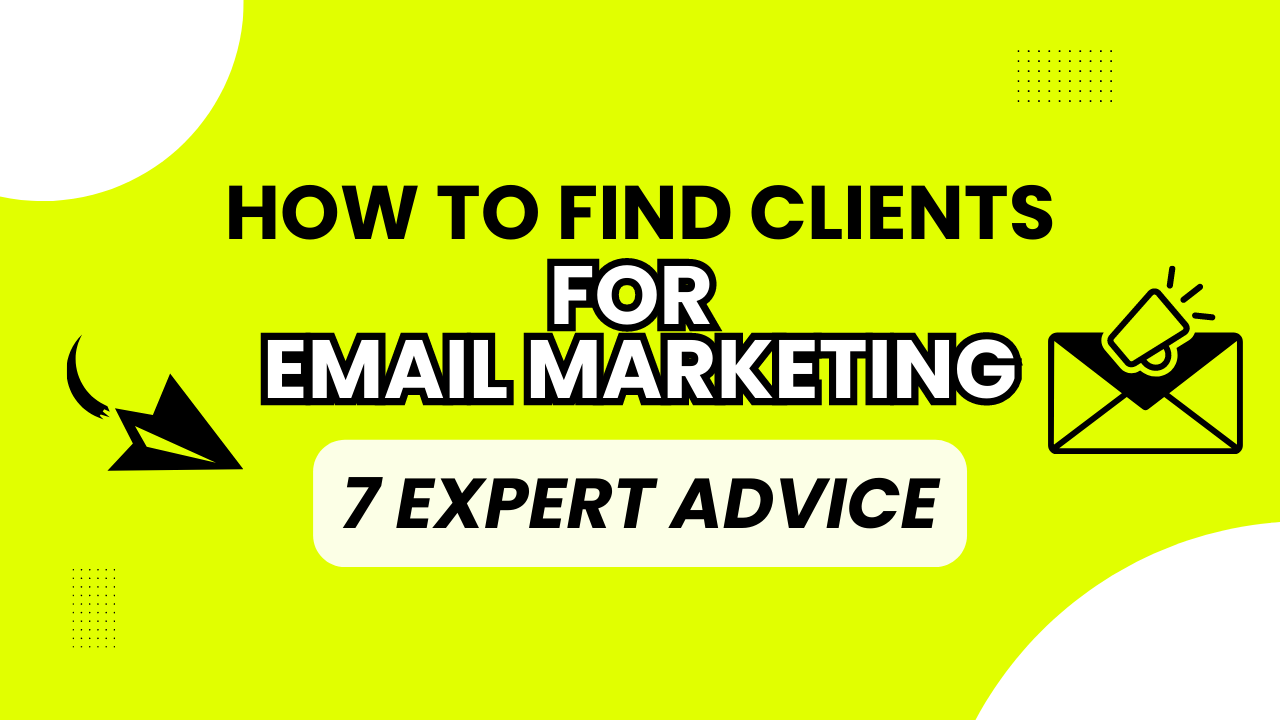So, you’ve got your email marketing game on point, right?
Your solopreneurship or agency knows everything that is possible to know in 2023?
Your keyboard blazes as you craft captivating subject lines.
The body of your emails hold stories that keep readers hanging on to every word.
Your call-to-action buttons?
They’re just begging to be clicked.
You’ve got this email marketing thing down to a science – and it’s awesome.
But now comes the real kicker: How do you find those ideal clients who need your top-notch services? You know, the ones who’ll pay you for your skills and abilities?
It’s a bit like looking for a needle in a haystack, isn’t it?
But don’t sweat it.
We’ve got a top-of-the-line, high-tech, digital magnet ready for you.
Summary
Welcome to the ultimate guide on finding clients for email marketing in 2023!
This isn’t just about casting a wide net and hoping for the best. It’s about precision, strategy, and hooking the right fish.
Whether you’re a seasoned email marketer or a newbie eager to conquer the digital world, this guide has something for everyone.
We’ll take you on a journey from identifying the right clients for your business, through setting up your groundwork and nailing your unique value proposition, right up to sealing the deal with your perfect prospects.
So, grab your gear, strap in, and let’s dive right into getting new clients in 2023!
Because the ocean of new clients is vast, and there’s plenty of fish for everyone who knows where to look.
What type of Clients need Email Marketing Services?

Knowing your target is the first step to a successful hunt and when it comes to email marketing, the terrain is diverse and packed with opportunities.
But who exactly needs your email marketing services?
Let’s take a closer look.
Small to Medium-Sized Businesses (SMBs)
These growing companies are hungry for effective marketing tactics to expand their reach.
They’re eager to establish brand loyalty, generate repeat business, and maintain steady growth.
However, they often lack the in-house resources to run full-scale email marketing campaigns.
That’s where you come in.
E-Commerce Businesses
For online retailers, email marketing is a goldmine.
It’s a direct line of communication to their customers, allowing them to announce new products, offer exclusive discounts, and keep shoppers engaged.
If you can deliver these results, you’ll be a treasured asset to any e-commerce operation.
SaaS Companies
These tech-savvy firms understand the power of digital marketing, and they often rely heavily on email campaigns to acquire new users, reduce churn, and upsell existing customers.
They need someone with a deep understanding of their industry and customer base – a role you’re primed to fill.
Non-Profit Organizations
Fundraising, awareness campaigns, volunteer recruitment – the list of tasks for non-profits is never-ending.
Email marketing can help lighten the load by effectively reaching their audiences.
If you can deliver heartfelt, engaging content that compels action, non-profits could become some of your most loyal clients.
Agencies
Other marketing agencies might have a roster of clients clamoring for email marketing, but lack the capacity or expertise to meet the demand.
They’re looking for reliable partners to deliver top-notch email campaigns – a fantastic opportunity for you to step in and shine.
So, who needs your email marketing services?
Almost any business or organization looking to build and nurture relationships with their audience.
The key lies in understanding their unique needs and tailoring your approach to meet them.
Now that we know who we’re looking for, let’s roll up our sleeves and get down to the nitty-gritty of preparing your own launchpad for success.
It’s time to lay down your groundwork.
Setup Stage – Establish the Foundations
Before we dive into the how-tos of finding clients for your email marketing offering, it’s important to set a solid foundation for your efforts.
You don’t want to dive into the ocean without ensuring your diving gear is in perfect shape.
In the same vein, your groundwork determines how effectively you can target and attract new clients.
Think of this phase as creating a magnetic field that irresistibly draws your ideal clients towards you.
It’s about ensuring that every aspect of your business, from your ideal customer profile to your website, resonates with the type of clients you’re looking to serve.
This preparation phase is crucial to ensure your success in the performing phase that follows.
Get ready to roll up your sleeves and dig deep – it’s time to lay down the groundwork!
Begin with Your Ideal Customer Profile (ICP)

It is 2023. If you don’t know who to target very specifically, thank you should take a step back.
Let’s begin with a fundamental piece of your groundwork – your Ideal Customer Profile (ICP).
An ICP isn’t just another buzzword to throw around in marketing meetings and agency settings.
It’s a well-defined, living map of who your perfect client is.
But why is it so important, and how do you create one?
Let’s break it down.
Imagine you’re a great tailor with amazing tools.
Your goal is to create the perfect suit.
You can choose the finest fabric, follow the latest fashion trends, and use the best sewing techniques.
But if you don’t have the measurements of the person who’ll be wearing the suit, chances are, it won’t fit well.
An ICP is like the measurements for your perfect suit – it allows you to tailor your offerings and marketing efforts to fit your clients perfectly.
To start defining your ICP, ask yourself some key questions:
- What type of business is your ideal client running?
- What industry are they in?
- How big is their company?
- Who makes the decisions?
- What challenges are they facing that your email marketing efforts can solve?
Remember, the more detailed you are, the better you’ll understand your target and the more effective your strategies will be.
Creating an ICP isn’t a one-time exercise.
It’s a process that evolves as your business grows and as you gain more insights into your clients.
So, keep refining, keep tailoring, and before you know it, you’ll have a perfect fit between your services, marketing and sales efforts, and your clients.
Now, with your ICP ready, it’s time to think about what makes you stand out in the crowded marketplace
Forge Your Unique Value Proposition (UVP)

Think of a marketplace as a bustling street filled with shops.
Each one is vying for the attention of passersby.
But only those with the most compelling offerings – the unique, irresistible ‘come on in’ – make people stop and enter.
That’s your UVP.
It’s your ‘come on in’.
It’s what makes you stand out, what makes new clients choose you over competitors.
But how do you create a compelling UVP?
It begins with identifying what you do exceptionally well.
Is it your expertise in a niche industry? Your knack for crafting engaging copy? Or perhaps your proven track record of driving conversions through strategic campaigns?
Once you’ve nailed down your strengths, look at how these can solve the problems your ICP is facing.
If your expertise can transform their pain points into growth opportunities, you’ve got a winning UVP.
Now weave these insights into a clear, concise statement.
Remember, simplicity is key.
Your UVP should be easily understood by anyone, whether they’re a marketing whiz or a business owner just dipping their toes into digital marketing.
Crafting a potent UVP is like polishing a diamond.
It takes time and effort, but the result is a unique, valuable gem that new clients won’t be able to resist.
So take the time to refine your UVP – it’s one of your most powerful tools in attracting clients for your email marketing services.
Refine Your Portfolio
Your portfolio is more than just a showcase of your past work, or a simple free tool to win over clients – it’s your personal highlight reel.
It’s the tangible proof of your expertise and the value you can bring to new clients.
But how do you create a portfolio that not just impresses, but convinces prospects that you’re the right person for the job?
Start by selecting your best work.
The key here is quality over quantity.
Choose projects that reflect your skills, creativity, and adaptability.
Display work that aligns with what you want to offer and the clients you want to attract.
If you’re new and don’t have many projects under your belt, consider creating mock campaigns. It’s a great way to showcase your abilities.
Next, add context.
Each entry in your portfolio should tell a story.
What was the client’s challenge?
How did you tackle it?
And what was the outcome?
Numbers are your friends here.
If you can quantify your results – an increase in open rates, click-through rates, or conversions – it adds weight to your claims.
And don’t forget to update your portfolio regularly.
This keeps it fresh and allows you to showcase your latest and greatest work.
Keep in mind, your portfolio is an evolving presentation of your capabilities. It grows and improves with you.
Design and Develop your Website

In today’s digital age, your website is often the first interaction potential clients have with your business.
It’s your digital storefront, your online business card, your 24/7 marketing machine.
As such, it plays a critical role in converting prospects into clients.
So how do you build a website that not only looks good but works hard for your email marketing services?
Let’s break it down.
Firstly, your website should reflect your brand.
From color schemes to fonts, every design element should be in harmony with your brand’s personality.
Ensure your Unique Value Proposition is front and center, immediately telling visitors why they should choose your Offers.
Secondly, make it easy for visitors to find what they’re looking for.
A clear, intuitive navigation menu helps guide visitors through your site, leading them closer to that ‘Contact Us’ button.
This includes having a dedicated page for your portfolio, making it easy for potential clients to see your work and results.
Don’t forget to make your website SEO-friendly.
The right mix of keywords, meta descriptions, and quality content will help increase your visibility on search engine result pages, bringing in more organic traffic.
Lastly, ensure your website is mobile-friendly.
With more than half of global web traffic coming from mobile devices, a mobile-optimized site is no longer an option – it’s a necessity.
Building a website might seem like a daunting task, but it’s an investment that can pay significant dividends.
A well-crafted website not only attracts potential clients but also helps convert them into actual ones.
Establish Your Social Media Presence
Imagine a party where everyone who’s anyone in your industry is present.
A place where you can introduce yourself, chat about your results, showcase your expertise, and even pick up a few leads.
This isn’t some exclusive gala at a swanky hotel, but rather, the world of social media.
Much like the perfect party guest, your social media presence needs to be engaging, likable, and, most importantly, memorable.
So, how do you make the most of your social media platforms like Instagram and Facebook to find clients for your email marketing services?
The first rule is to choose your platforms wisely.
You don’t have to be everywhere; you just have to be where your potential clients are.
If they’re C-suite executives, you might find them on LinkedIn.
If they’re small business owners, they could be scrolling through Facebook or Instagram.
Facebook and Instagram have the best environment for startups and SMBs because they are free, easy to use and almost always up and running. They also offer free tools and resources to learn how to utilize them and work properly, build contact with your target audience and start your campaign correctly.
Once you’ve chosen your platforms, it’s time to create content that engages and informs.
Share insights about email marketing, showcase your latest projects, share industry news, or provide tips and tricks.
The goal is to establish yourself as an expert in your field, whether you do it through Facebook or LinkedIn.
Don’t forget to engage with your audience.
Respond to comments, join discussions, share resources and even start a few of your own.
Social media isn’t just a broadcast platform; it’s a two-way communication channel.
Lastly, be consistent.
Just like at a party, the person who shows up once and then disappears doesn’t make a lasting impression.
Consistently post and engage with your audience to keep your brand at the forefront of their minds.
Social media can seem like a busy, noisy party, but with the right strategy, it can be the perfect place to mingle with potential clients.
Take Off by Utilizing Light CRM
Think of your business interactions as a bustling city.
Prospects, leads, clients – they’re all inhabitants in this city, each living in a different street.
Without a proper map and efficient transportation system, navigating through this city can be overwhelming.
That’s where a Customer Relationship Management (CRM) system comes into play.
It’s your map and your subway, helping you navigate through the city of business interactions with ease.
But why start with a light CRM when you’re just laying the groundwork for your business?
Simply put, it sets you up for scalability. It is a free resource to drain your business success!
It enables you to organize your contacts, track your interactions, and automate tasks from the get-go, making growth less chaotic and more systematic.
A light CRM system helps you keep track of who your prospects are, where they are in the sales funnel, what interactions you’ve had with them, and when you need to follow up.
As your business grows and you gain more clients, a light CRM evolves with you.
It allows you to automate more tasks, integrate with other tools, and even predict sales trends.
It’s not just about making your life easier (although it does that very well); it’s about providing better service to your clients, which in turn leads to more business.
Starting with a light CRM may seem like a small step, but it can lead to big leaps in productivity, service quality, and ultimately, client acquisition.
So, set up that CRM system, and watch your city of business interactions become a well-oiled, thriving metropolis.
Establish Pricing Structures and Bundles

Think of pricing as a delicate dance.
Set your prices too high, and potential clients may be deterred.
Set them too low, and you may not earn enough to keep the lights on.
Finding the right balance is crucial – not just for the health of your business, but also for attracting the right clients for your email marketing services.
So how do you strike that balance?
Here’s a step-by-step guide:
First, understand your costs.
Factor in everything – from software subscriptions and office space to your involvement.
Knowing your costs will help you set a baseline for your prices.
Next, research your competitors.
What are they charging for similar services?
This gives you a ballpark of what clients might be willing to pay.
However, remember that competition-based pricing is just a guide, not a rule.
Then, consider the value you’re providing.
If you’re consistently helping clients grow their business, don’t shy away from pricing that reflects that value.
After all, good email marketing isn’t an expense – it’s an investment.
Once you have your pricing, structure it into packages.
Clients love packages because they’re easy to understand and show exactly what they’re getting for their money.
Start with three tiers – basic, standard, and premium.
Each tier offers more value than the previous one, enticing clients to go for the higher-priced packages.
Lastly, review your pricing regularly.
As your business evolves, your prices should too.
Always ensure they reflect the value you’re providing.
Pricing may seem like a complex dance, but with the right steps, you can find the perfect rhythm. And once you do, you’re well on your way to attracting and retaining clients for your email marketing services.
Now that the groundwork is laid, let’s get into action. Let’s move on to the performing phase and dive into how to find more clients for your email marketing services.
Performing Phase – 7 ways to get more clients for Email Marketing Services
So, you’ve built a solid foundation. You know who your ideal clients are. You’ve crafted a compelling Unique Value Proposition, polished your portfolio, created an engaging website, become an active participant on social media, and even set up your light CRM and pricing.
Now comes the exciting part – putting your groundwork into action and actually finding clients for your email marketing services.
Just like a well-rehearsed dance number, it has come to hit the stage and captivate your audience.
Except, in this case, your audience comprises potential clients, and your dance moves are strategic methods to attract and engage them.
In this performing phase, we’ll explore seven expert-approved ways to find clients for your email marketing services.
These are proven strategies that can turn prospects into clients.
They’ll help you build relationships, showcase your expertise, and grow your business.
Are you ready to take the stage?

Directories
Directories – they’re like the modern Yellow Pages for your business.
They’re online platforms where companies are listed according to their services, industries, locations, and more.
For an email marketer seeking to attract clients, directories can be your gold mine of prospects.
But how do you use directories to your advantage?
Let’s break it down.
The first step is to find the right directories.
There are general directories like Google My Business, Yelp, and LinkedIn Company Directory, but don’t ignore the niche ones that cater specifically to your industry or the industries of your ideal clients.
Once you’ve identified your directories, create your listing.
Ensure your profile is complete and accurate.
Include a description of your services, your unique value proposition, contact details, and even customer testimonials if possible.
Remember, your listing is your miniature billboard on the directory, so make it count.
Next, optimize your listing for search.
Just as you would optimize your website for SEO, do the same for your directory listing.
Use keywords that your potential clients would use when looking for email marketing services.
Lastly, keep your listing updated.
If your services, contact details, or business hours change, make sure your listing reflects that.
Being listed on directories might seem like a passive strategy, but with an optimized and up-to-date profile, it can be an effective way to be found by potential clients actively looking for your services.
Content Marketing

When it comes to marketing, content is still king. And rightly so. It educates, engages, and, when done right, converts.
For email marketing service providers, content marketing offers a way to demonstrate your expertise, provide value to potential clients, and build trust – the cornerstones of any successful business relationship.
But what does effective content marketing look like?
Firstly, it’s consistent.
Whether it’s a blog post, a YouTube video, a podcast, or a social media update, regularly producing content keeps your brand in the minds of potential clients.
It’s like always being the one to initiate a conversation, keeping the lines of communication open and flowing.
Secondly, effective content is valuable.
It’s not about you; it’s about your audience – your potential clients.
What problems are they trying to solve?
What questions do they have?
What information would help them run their business better?
Answer these questions through your content, and you’re providing value.
Thirdly, great content is engaging.
It encourages interaction, whether that’s a comment, a share, or a click on a call-to-action.
Don’t just talk at your audience – converse with them.
Encourage them to participate, to join the dialogue.
And lastly, ensure your content is SEO-friendly.
One of the amazing things in content marketing is utilizing blog content as part of your positioning strategy. Blog strategy can be a very effective tool to increase awareness and hit your target audience in the different parts of their customer journey. Also, don’t forget to utilize your blog for resharing content on your social media channels before the blog posts increase their rankings in SERPs.
Use relevant keywords, meta tags, and alt text.
This will increase the visibility of your content.
Content marketing isn’t merely about selling your services – it’s about carving your space in the industry as a trusted expert.
When you’ve achieved that, when you’ve become the go-to authority for insightful, engaging content, transforming prospects into clients no longer seems like a hard sell.
Instead, it becomes a natural progression in a relationship built on trust and mutual value.
So, wield your words wisely, and watch as they unlock new doors to potential clients.
Email Lists and Newsletter

In the realm of digital marketing, an email list is like a golden ticket.
It’s direct access to people who have expressed interest in your services – a virtual stage where you have your audience’s attention.
Coupled with a well-crafted newsletter, it’s a potent tool for converting prospects into clients.
So, how do you build an email list, and what role does a newsletter play in it?
Start with offering something of value.
A lead magnet – a free piece of high-value content – can be a powerful incentive for visitors to give you their email address.
This could be an e-book, a checklist, a whitepaper, or even an exclusive video. T
The key is to offer something that your potential clients will find useful.
Next, make it easy for people to sign up.
A simple form on your website or social media platforms can work wonders.
Remember, the easier it is for visitors to sign up, the more likely they are to do so.
Now, let’s talk about newsletters.
They’re your regular check-ins with your email list – your opportunity to provide value, showcase your expertise, and build relationships.
Whether it’s sharing helpful tips, industry news, or updates about your services, your newsletter should be interesting, engaging, and representative of your brand.
But what sets a great newsletter apart is its focus on the reader.
It’s not a sales pitch; it’s a value proposition.
Your goal is to build a relationship, not to sell (at least, not directly).
The selling happens naturally when your readers see the value you provide and decide they want more.
Building an email list and creating a compelling newsletter may seem like a big task, but remember – every journey starts with a single step. And every email address you collect is a step closer to a potential client.
Partner Up with Complementary Businesses – Agencies
Two heads are better than one, and in the world of business, two companies can be better than one as well. When you find the right agency, you will feel like you hit the gold mine!
Partnering up with another business or an agency that complements yours is a mutually beneficial strategy that can significantly boost your visibility and client acquisition efforts.
The successful agency doesn’t have to explain a ton to their customers why their additional offer is the best on the market. A reputable agency can vouch for you, even though you showcased them only
But how does it work, and how do you go about it?
Start by identifying businesses that offer complementary services to yours.
General marketing agency probably has their own Email Marketing personnel. Those agencies should be out of consideration!
For instance, as an email marketing service provider, you could partner with a web design agency, an SEO specialist, or a social media marketing company.
These are businesses that serve the same audience as you, but their services don’t compete with yours – instead, they enhance each other.
Once you’ve identified agencies, reach out to them with a collaboration proposal.
This could involve referring clients to each other, offering bundled services, or co-hosting webinars or workshops.
The goal is to provide value to each other’s clients while also attracting new ones.
An effective partnership is a win-win-win scenario.
Your business wins by reaching more possible clients, your partner’s business wins by offering additional value to their clients, and the clients win by getting a more comprehensive set of services.
But remember, successful partnerships are built on mutual respect and shared goals.
Make sure you choose an agency whose values align with yours and who are just as committed to providing excellent service as you are.
By strategically partnering with complementary businesses, you not only amplify your reach but also strengthen your offering, making your email marketing services even more attractive to prospective clients.
LinkedIn – Blend of Organic and Paid Strategies
LinkedIn – it’s the corporate playground, the professional’s social network, and, when leveraged correctly, an incredibly powerful tool for finding clients for your email marketing services.
With both organic and paid options at your disposal, LinkedIn provides a multifaceted approach to your client acquisition strategy.
Let’s start with the organic route.
LinkedIn is about building connections and sharing insights. When you are done, you can start your campaign!
Start by optimizing your profile.
Make it clear in your headline and summary that you offer email marketing services.
Use the ‘About’ section to highlight your UVP and expertise.
Once your profile is polished, start building your network.
Connect with individuals who fit your ICP, join relevant groups, and actively participate in discussions.
Share content that showcases your knowledge in email marketing and offers value to your connections.
But, don’t just stop at posting content and have your campaign run.
Engage with your network.
Comment on their posts, celebrate their wins, and provide value whenever you can.
The goal here is to build relationships and establish yourself as a trusted expert in your field.
Now, let’s look at the paid route – LinkedIn Ads.
Advertising on LinkedIn can provide a significant boost to your visibility and lead generation efforts. You can create a campaign to target based on industry, company size, job function, and more, making it easier to reach your ICP.
There are various ad formats to choose from, such as Sponsored Content, Message Ads, or Dynamic Ads.
Each has its advantages, so choose the one that aligns with your goals and budget.
With a strategic approach to LinkedIn, both organic and paid, you can transform this professional networking site into a client acquisition powerhouse for your email marketing services.
Build Connections – Networking

Networking – it’s a term that often conjures up images of awkward social events, handing out business cards to strangers, and making small talk.
But in reality, networking is so much more than that.
It’s about building meaningful, beneficial relationships that can help drive your business forward.
So, how can networking help you find clients for your email marketing services?
Firstly, networking, whether in person or online, allows you to meet possible clients or a partner agency.
These might not be individuals who need your services right now, but if you make a positive, memorable impression, they’ll remember you when they do.
Secondly, networking can lead to referrals.
When you build strong relationships with other professionals, they’re more likely to recommend your services to their contacts.
And these aren’t just any leads; these are leads who come pre-warmed, with a level of trust already built in.
But effective networking isn’t about attending every event or joining every online community.
It’s about being strategic.
Choose networking opportunities where your future clients are likely to be.
This could be industry-specific events, online forums, or professional groups on social media.
Once you’re there, focus on building relationships, not just handing out business cards.
Show genuine interest in the other person.
Ask about their business challenges.
Offer advice if you can.
The goal is to be remembered as a helpful, knowledgeable professional.
Lastly, don’t forget to follow up after the event.
Send a quick message expressing your pleasure at meeting the person and your interest in keeping in touch.
This helps solidify the relationship and keeps you top of mind for future opportunities.
Remember, networking is a long-term strategy.
It might not lead to immediate clients, but the relationships you build can pay off significantly in the long run.
Get Referrals from your Existing Clients
In the hustle and bustle of attracting new clients, it’s easy to overlook a valuable resource that’s already within your grasp – your existing clients.
They’ve experienced your services first-hand.
They know the quality of your work.
In essence, they’re perfectly placed to be ambassadors for your email marketing services.
How?
Through referrals.
A referral isn’t just a lead – it’s a lead with a seal of approval.
It’s a vote of confidence from someone who trusts you and your services.
This trust significantly shortens the sales cycle and increases the likelihood of conversion.
But how do you go about asking for referrals?
Firstly, don’t be shy about it.
If you’ve provided excellent service and your client is happy, most will be more than willing to refer you.
Remember, the worst they can say is no.
Secondly, timing is key.
The best way to ask for a referral is right after delivering exceptional value – after a successful campaign, for example, or when you’ve solved a significant problem for the client.
Consider creating a referral program.
This could be a simple ‘thank you’ note, a discount on future services, or even a small gift.
This not only incentivizes clients to refer you but also shows your appreciation for their support.
However, never lose sight of the fact that the foundation for gaining referrals lies in providing excellent service.
If your clients are satisfied and see the value in what you offer, they’ll naturally want to spread the word.
Remember, a happy client can be your most powerful marketing tool.
So, keep delivering exceptional results, ask for referrals, and watch as your client base grows.
Extra tip: Send Personalized Proposals!
In a world where automated emails and generic marketing messages are the norm, personalization can make you stand out.
This is especially true when it comes to proposals.
A personalized proposal shows potential clients that you’ve taken the time to understand their needs, their challenges, and their goals.
It communicates that you’re not just selling a service, but offering a solution tailored to them.
So, how do you create a personalized proposal?
Firstly, it should be client-focused.
Yes, you’ll talk about your offers, your past work, and your expertise, but it should all be framed in the context of the client.
How can you help them?
How have you helped similar businesses in the past?
The spotlight should be on the value you can provide to the client.
Secondly, address the client’s pain points.
If they’ve mentioned specific challenges during your conversations, bring these up in your proposal.
Show them that you’ve listened and understood their problems, and propose concrete ways you can help solve them.
Thirdly, use the client’s language.
Take a closer look if people in your niche don’t like referring to themselves as Customers. If competition refers to their customers as ‘guests’ or their services as ‘experiences’, do the same. Surely, customers will appreciate it!
This not only shows that you’ve paid attention, but it also helps the client see that you’re on the same page.
A personalized proposal takes more effort than a generic one, but it’s an effort that can pay off.
It can be the difference between a potential client seeing you as just another service provider and seeing you as a partner who understands and caters to their unique needs.
Lead Scoring
Imagine you’re fishing in a lake filled with potential clients.
Some are just nibbling, not quite ready to bite.
Others are tugging at your line, almost ready to be reeled in.
But how do you tell which is which?
That’s where lead scoring comes in.
Lead scoring is a system of assigning values, or scores, to each of your leads based on their interactions with your business and their fit with your ICP.
The goal is to identify the ‘hot’ leads – the ones that are most likely to convert into clients.
Creating a lead scoring system starts with identifying the attributes and behaviors that indicate a lead’s readiness to buy.
This could include things like downloading a piece of content, visiting your pricing page, or interacting with your emails.
The behaviors that are more indicative of purchase intent get higher scores.
Similarly, you’ll want to score leads based on their fit with your ICP.
The closer the fit, the higher the score.
Once you’ve set up your lead scoring system, you can use these scores to prioritize your leads.
You can focus your efforts on the leads that are most likely ready to become clients, increasing the efficiency of your sales process.
While setting up a lead scoring system might require some effort upfront, the payoff in increased efficiency and better lead prioritization can be substantial.
Measurement of Success and Testing New Theory
Success, much like beauty, is in the eye of the beholder.
In business, it’s in the eye of the beholder, the hands of the strategist, and the data of the analyst.
Defining what success looks like for your email marketing service, measuring it, and continually refining your approach based on data, are crucial steps to long-term growth and stability.
Defining success starts with setting clear, measurable goals.
Are you aiming for a certain number of new clients each month?
Or perhaps you’re targeting a specific increase in revenue or profit margin?
Make your goals specific, measurable, achievable, relevant, and time-bound – or SMART, for short.
Next, you’ll need to identify the key performance indicators (KPIs) that will tell you if you’re on track to achieve these goals.
If your goal is to gain new clients, your KPIs might include the number of new leads generated, the conversion rate of leads to clients, and the cost per acquisition.
With your goals and KPIs in place, it’s time to measure.
Use your CRM, your website analytics, your social media insights – any data that will tell you how well you’re doing.
But don’t just collect data – analyze it.
Look for patterns and trends.
Are there certain marketing tactics that are driving more leads?
Are there particular offers that are more profitable?
The insights you gain from analyzing your data can guide your decision-making and help refine your strategies.
And finally, test.
Success is not a destination, but a journey of continuous improvement.
Try new tactics, test new theories, and don’t be afraid to fail.
Every test, every failure, is an opportunity to learn and improve.
As you embark on this journey, be mindful that the path to success is rarely a straight line.
It’s a dynamic, winding road, constantly changing as your business evolves.
Stay flexible, stay adaptable, and let your data illuminate your path.
Your pursuit of success isn’t merely a journey, it’s an adventure – one that’s guided by insight, shaped by adaptation, and powered by determination.
Find High Quality Prospect and Close Deals Faster with ZeroIn!
In the dynamic world of client acquisition for email marketing services, a single tool can significantly shape your journey towards finding high-quality prospects – ZeroIn.
This game-changing email discovery platform is more than a tool; it’s your key to unlocking a seamless, efficient, and highly effective prospecting process.
Think of ZeroIn as your advanced LinkedIn search companion.
Whether you’re using LinkedIn Free or Sales Navigator, ZeroIn effortlessly integrates with your searches.
It’s like having an all-seeing magnifying glass, giving you an in-depth view of potential clients based on your unique search criteria.
But ZeroIn doesn’t stop at just contact details.
It digs deeper, gifting you with over 20 additional insights about your contacts and their organizations.
Imagine knowing your prospects so intimately that each pitch you craft resonates, strikes a chord, and pushes them further down the conversion funnel.
From verified business emails to a robust 10-step verification process, ZeroIn ensures that you’re knocking on the right digital doors.
Each of its 26 distinctive data points guides you towards the right people at the right addresses, maximizing your outreach efforts.
Whether you’re looking to import, re-verify, or export leads, ZeroIn is your one-stop solution, streamlining your journey to get more clients for your email marketing services.
It’s time to take your client acquisition game to the next level.
Start your journey with ZeroIn and watch your prospects convert into clients faster than ever before.
Why wait when you can ZeroIn?
Companies that use ZeroIn:
Contact us/Book a Demo/ Get 25 free Credits/ Create a Free Account and Get 25 credits!
